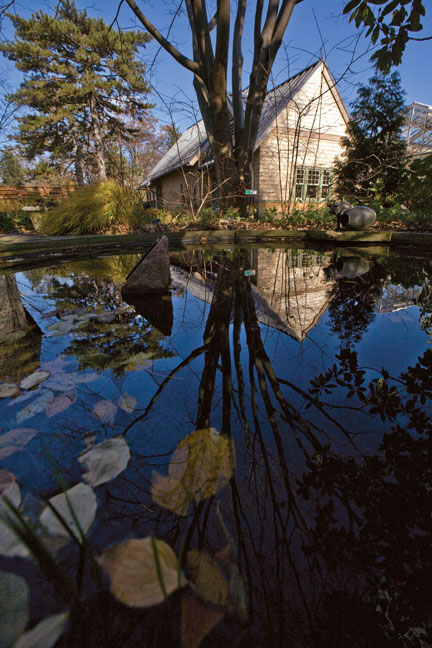For Soil and Pots, Plants and People
Another beautiful structure has arisen to grace Swarthmore’s campus. Adding to the reds, yellows, and golds of autumn, the new Wister Education Center and Greenhouse—the College’s “greenest” new construction so far—opened in early November to high expectations for a “silver” award from LEED (Leadership in Energy and Environmental Design).
Chosen from among more than 2,500 nominations, the energy-efficient, $2.8 million center, for which funds were raised before the economic crisis, has already received a Green Building of America Award from Real Estate and Construction Review, which will highlight it in early 2010. The 5,200-square-foot center, designed by Archer & Buchanan Architecture of West Chester, Pa., nestles into the slope between Cunningham House and Willetts Hall. It houses a classroom for educational activities, space for horticultural displays and plant evaluations, rooms for staff and volunteers, a kitchenette, and a reception lobby.
Attached to the Wister Center is a 1,750-square-foot greenhouse complex, designed by Rough Bros., Inc. It includes a specialized section named the Sharpless Propagation Greenhouse, and it replaces the 25-year-old, 1,000-square-foot Wister Greenhouse.
The exterior walls of the education center are faced with 381 square feet of metasequoia shingles produced from a grove of 12 large dawn redwoods (Metasequoia glyptostroboides) that were removed from the campus in 2004 and recycled into shingles by CitiLog, a firm that specializes in trees that have fallen naturally, been removed to accommodate a construction project, or saved from a demolition project. Another 100 square feet of cedar shingles complete the external wall covering.
Other features include a rainwater cistern to help irrigate the surrounding gardens, an energy-exchange system with McCabe Library to provide air-conditioning to the center, and the campus’s fourth green roof, from which Sedum, Talinum, Delosperma, Campanula, Allium, and Dianthus will emerge in spring.
“At last, we have a space designed for hands-on horticultural educational programs, where soil and pots, plants and people can flourish,” Claire Sawyers, arboretum director, says.
 Email This Page
Email This Page
